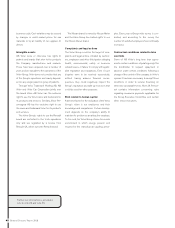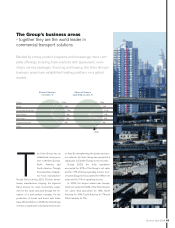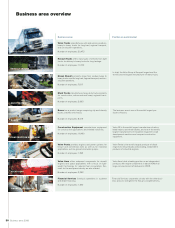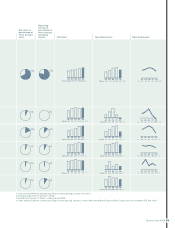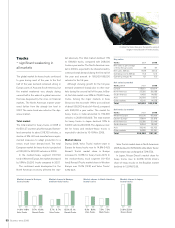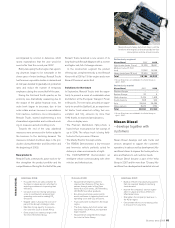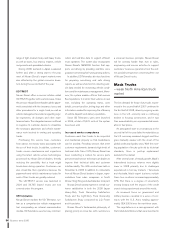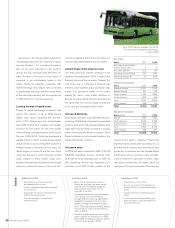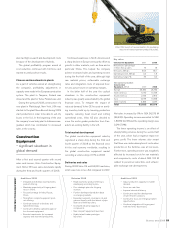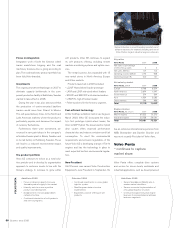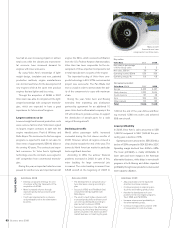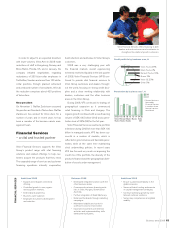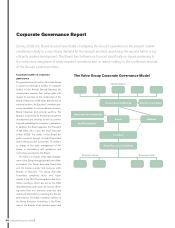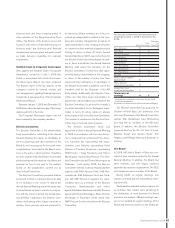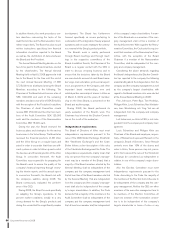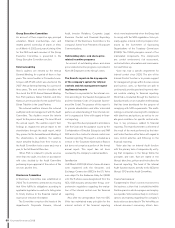Volvo 2008 Annual Report Download - page 62
Download and view the complete annual report
Please find page 62 of the 2008 Volvo annual report below. You can navigate through the pages in the report by either clicking on the pages listed below, or by using the keyword search tool below to find specific information within the annual report.
Demands on the transportation industry for
substantially improved fuel economy is grow-
ing ever stronger – for a number of reasons.
One of the most important is the need to
reduce the CO2 emissions that affect the cli-
mate. Another is the price of fuel, which is
expected to be considerably higher in the
future. Thanks to catalyctic converters with
SCR-technology, Volvo Buses has succeeded
in signifi cantly reducing emission levels while
at the same time lowering fuel consumption by
5–10%. But this is only the beginning.
Leading the way in hybrid buses
Thanks to hybrid technology, customers can
expect fuel savings of up to 30%. During
2008, Volvo Buses launched the low-fl oor
Volvo 7700 Hybrid and the doubledecker
Volvo B5L Hybrid. The company immediately
received its fi rst orders for the new model,
which will begin serial production at the turn of
the year 2009/2010. Volvo has developed a
parallel hybrid in which a small diesel engine
and an electric motor work together and where
braking energy is recovered. At bus stops, the
diesel engine is turned off and the bus starts
using only the electric motor. The price is kept
down, thanks to Volvo mainly using com-
ponents that have been developed inhouse and
which are common for buses, trucks and con-
struction equipment. For the fi rst time there is a
commercially viable hybrid bus in the market.
Limited impact from fi nancial crisis
The total world bus market continued to be
stable for the main part of 2008, in spite of the
fi nancial crisis and the recession. Towards the
end of the year, a softening of demand was
noted in some markets and in particular seg-
ments. This pertained mainly to the coach
market for which order intake declined in
Europe as well as North America and Asia. At
the same time, the city bus market continued
to be strong in most parts of the world.
Increased deliveries
Volvo delivered 9,937 buses (9,916) and chas-
sis during 2008. Sales increased in important
markets such as the UK, Germany, Mexico and
India while they declined somewhat in among
others China and the Nordic countries. Volvo
Buses continues to be the market leader in the
UK and the Nordic countries.
Increased sales
In 2008, net sales increased to SEK 17,312 M
(16,608). Operating income declined from
SEK 231 M to an operating loss of SEK 76
Mkr. Operating income was impacted by a
one-time cost of SEK 110 M in relation to the
closure of the plant in Tampere, Finland. An
important factor behind the operating loss is
an unfavorable currency mix. Volvo Buses has
production in countries such as Canada, Brazil
and Poland, whose currencies have strength-
ened in relation to currencies in which sales
take place, primarily the US dollar, which for
most part of the year was weak. The company
Outcome 2008 Ambitions 2009Ambitions 2008
More effi cient production system in •
Europe as one plant has been closed
and one sold. Profi tability programs
have lowered the product cost for
a number of models.
Increased competence regarding buses •
in the Group’s service workshops
through extensive training. Spare parts
availability increased, in terms of geo-
graphic coverage and number of parts.
Volvo 7700 Hybrid and Volvo B5L Hybrid •
launched. First order received. Delivery
starts in 2009.
Nova Bus started building a new city bus •
plant in the US for introdcution in 2009.
Volvo 9700 from Mexico ready for launch
in the US and Canada in 2009.
Strong focus on cash fl ow. •
Secure a successful introduction of •
buses with Euro V engines and hybrid
buses.
Increased efforts in developing soft •
offers.
Continued work with profi tability pro-•
gram focused on selective expansion
and reduced costs.
Strong focus on cost control and •
decreased product costs.
Further strengthen aftermarket support •
for customers.
Guarantee successful introduction of •
hybrid technology buses.
Focused strategy for expansion in •
North America.
BUSES
Volvo 7700 Hybrid is available from 2009.
The hybrid technology brings fuel savings
of up to 30%.
Net sales by market
Buses, SEK M 2007 2008
Europe 7,767 7,321
North America 4,630 5,355
South America 1,623 1,571
Asia 1,802 2,094
Other markets 786 971
Total 16,608 17,312
Deliveries by market
Buses 2007 2008
Western Europe 3,377 3,140
Eastern Europe 371 173
North America 1,547 1,884
South America 1,318 995
Asia 2,757 3,033
Other markets 546 712
Total 9,916 9,937
Key ratios
Buses 2007 2008
Net sales as percentage
of Volvo Group sales 66
Net sales, SEK bn 16.6 17.3
Operating income, SEK M 231 (76)
Operating margin, % 1.4 (0.4)
Business areas 2008
58


